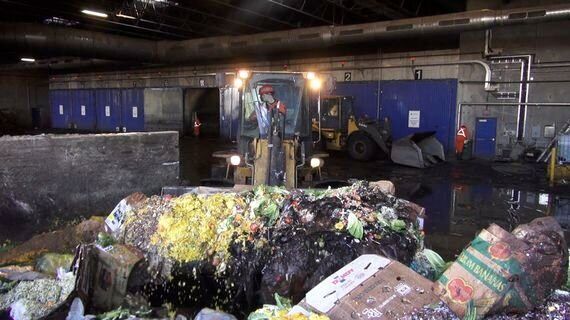Picture one meal in your day and imagine it getting tossed into the trash before you even got a chance to bite into it.
Every single day we either lose or waste one third of our food -- that's 1.3-billion tonnes a year. Not only could we have fed people with that food but it's an astonishing waste of energy as well. Just think of all the energy that goes into growing, fertilizing, processing and transporting 1.3-billion tonnes of food a year.
To let the gravity of this wastage sink in head to this infographic and mouse around it for a while. Go ahead, we'll give you a minute.
Harvest Power has a partial solution. We visited their site in Richmond, B.C., one of 38 similar operations across North America that turn your rotten bananas and wilted lettuce into energy and compost.
Harvest works with 13 municipalities and numerous commercial food waste haulers in the Lower Mainland to handle their organic food and yard waste. And the amounts are big, they handle over 200,000 tonnes of waste a year. Of that 40,000 tonnes is diverted to what they call the energy garden. It sounds nice and pretty and bucolic, but to see a truck dumping gooey, mushy organic waste doesn't exactly make me think of any garden I've ever been to.

About 40,000 tonnes of food and organic waste enter the energy garden where it is fed into a digester to produce methane and electricity.
The Energy Garden
Trucks back up, dump the food waste onto the tipping floor where it's mixed with yard waste, shredded and then pushed into long, rectangular chambers with airtight doors. When those doors are sealed the organic materials are biochemically degraded into organic acids. The solid materials go back into the compost stream and the organic liquids go into the digester where anaerobic bacteria release methane that is used to fuel a one-megawatt cogeneration powerplant.
Turning all of that food waste into energy is a good idea, but the anaerobic digestion process leaves you with a hot mess called digestate. Harvest Power closes the loop by composting the scentless but not very appetizing looking digestate.
When you see the Harvest Power site (see our video or take a tour) it looks like acres and acres of compost covered by thousands of gulls with a few dozen bald eagles sprinkled in to liven things up.
Composting is a pretty simple process -- mix food waste with woody or leafy yard waste, make sure there's enough water (not a problem in rainy B.C.) and move it around enough to make sure oxygen can get in. Obviously managing a composting operation that handles 200,000 tonnes a year is a complex operation, but food waste, yard waste, water and air are the four basic ingredients.
"We're doing 100 or more than 100 trucks per day, covering 30 or 40 acres. So the challenge is managing to the scale of a centimetre on the operation that's very large, and really what that means is getting one's hands dirty. So knowing what's happening on the site by a handful-by-handful basis. So it's just diligent management and attention to detail," says Geoff Hill, the manager of the compost operation. Hill knows the subject well, he has a PhD in composting.
The aerobic, or oxygen loving composting operation is just as important as the anaerobic, or oxygen starved digestion process, as it keeps the smell down and creates an important new revenue stream for Harvest Power. The composting operation completes the life cycle of food and actually imitates nature. No other species out there has garbage dumps or landfills and Harvest Power treats food waste as just another nutrient circulating in a healthy ecosystem.
When you actually break down how Harvest Power makes its money the energy generation side of things is just icing on the cake.
The tipping fees are the biggest moneymaker as they charge roughly $50 a tonne for truck after truck to drop off their waste. The second most important source of revenue is the sale of the compost, which sells for $20 a cubic yard. And third is the money generated by their one-megawatt plant producing and selling electricity to the grid.
We've covered innovative waste management in Nanaimo and landfill gas in Edmonton before, but turning our food waste into energy and compost appears to be a way to virtually eliminate the flow of food and organic waste to landfills. And without coincidence the City of Vancouver is set to ban organic waste from landfills by 2015.
It already costs less than a landfill to dispose of organic waste at Harvest Power. While it's still a good idea for North Americans to reduce their organic and food waste, integrated operations like Harvest Power are pointing the way to a zero waste future.